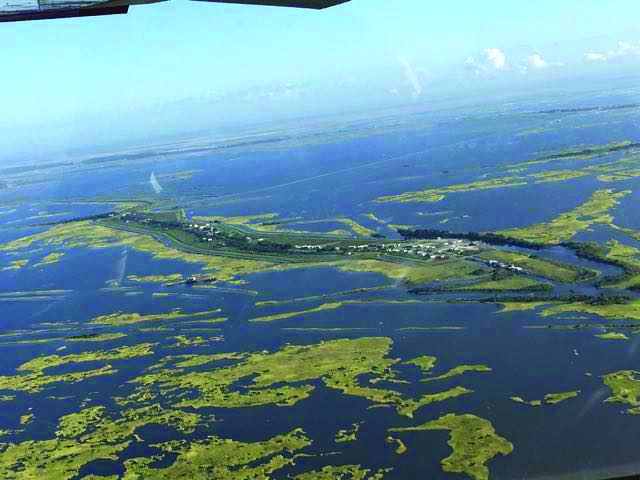Population displaced, culture affected by coastal land loss of Isle de Jean Charles
Isle de Jean Charles, 75 miles south of New Orleans and inhabited by the Biloxi-Chitimacha-Choctaw tribe, has lost 98 percent of its land to the Gulf of Mexico’s waters. The encroaching waters have eroded the land, disrupting the homes and culture of the community.
As a result of coastal erosion, climate change and other factors, Louisiana’s coastline is subsiding at a rate of 9 mm per year, according to a report recently released by The Geological Society of America.  Anh Nguyen | Associate Artist
Anh Nguyen | Associate Artist
According to Amy Lesen, research associate professor at The ByWater Institute of Tulane University, subsidence is partially a result of salt water intrusion. This process happens when salt water is dredged into the marshes as a result of oil and gas exploration, allowing saltwater to get into the freshwater marshes, killing the plants that live there. Water intrusion is a cause of subsidence, but subsidence is also happening naturally.
On Jan. 21, 2016, the U.S. Department of Housing and Urban Development awarded the tribe $48 million to relocate through the National Disaster Resilience Competition. As one of the first climate refugee populations, the tribe is setting a precedent in how the government and community will cooperate in solving the population relocation crisis.
“There will always be a refugee population, but the fact that this one is specifically human-caused and a cause by the environment, by the effect humans have had on the environment,” John Harris Alexander, director of sustainability for Tulane’s Undergraduate Student Government, said. “I think it specifically shows that, ‘hey, we need to do something about this.'”
Tulane researchers and tribal leaders are working together to combat the issue of relocation and its effects on culture and cohesion. Led by the Lowlander Center, a Terrebonne Parish nonprofit, these individuals have fostered innovative ideas such as an interactive science center. These efforts are being funded by a $200,000 dollar grant from the National Academies of Science, Engineering and Medicine’s Gulf Research Program.
“It’s not just moving people … but making sure that the move is happening in [a] way that really preserves the cohesiveness of the tribe, that preserves the traditions, and the relationships and the cultural practices that they have,” Lesen said.
Once a 22,400-acre island, Isle de Jean Charles is now only a 320-acre strip. The land mass loss from Isle de Jean Charles impacts more than the homes and traditions of the tribe.
Noa Elliott, treasurer and member of the leadership team for Divest, a student organization advocating to divest Tulane endowment funds from fossil fuels and move toward sustainable community solutions, said she believes coastal erosion will impact sectors as broad as the economy and energy sector of Louisiana.
“It will change our ecosystems, affect the people and economies living there and have some pretty severe effects on the fishing and seafood industries as well,” Elliott said.
Climate change is projected to transform coastal communities around the world. By 2050 an estimated 200 million people in coastal communities could have to be relocated. The 60 coming from Isle de Jean Charles could mark only the first drop in the bucket. Sociological research may help predict how climate refugee relocation can stifle the preservation of culture in affected communities.
“Their culture’s wrapped up with this community, with this location … how is that affected by a relocation effort?” Alexander asked. “Is their culture forever changed by that, which it probably will be, but how does that affect the population and these ties that have so closely held them together?”
Researchers and members of the community are working to combine their varying backgrounds and knowledge to provide the most qualified and cohesive answer to the problems proposed by relocation.
According to Lesen, the coastal land loss of Isle de Jean Charles marks a crisis for the region.
“Isle de Jean Charles is the extreme example of a community that is dealing with increased flooding [and] increased danger,” Lesen said. “There are many communities along the coast that are facing these issues [and] will be facing them, so what to do about this problem is the larger implication.”
Your donation will support the student journalists of Tulane University. Your contribution will allow us to purchase equipment and cover our annual website hosting costs.

















Leave a Comment